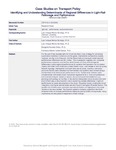Mostrar o rexistro simple do ítem
Identifying and understanding determinants of regional differences in light-rail patronage and performance
| dc.contributor.author | Ramos-Santiago, Luis Enrique | |
| dc.contributor.author | Novales, Margarita | |
| dc.contributor.author | Varela-García, Francisco-Alberto | |
| dc.date.accessioned | 2023-12-26T12:50:32Z | |
| dc.date.issued | 2022 | |
| dc.identifier.citation | Ramos-Santiago, L. E., Novales, M., Varela-García, F. A. (2022). Identifying and understanding determinants of regional differences in light-rail patronage and performance. Case Studies on Transport Policy, 10(2), 1188-1206. https://doi.org/10.1016/j.cstp.2022.04.005 | es_ES |
| dc.identifier.uri | http://hdl.handle.net/2183/34646 | |
| dc.description | Versión aceptada do artigo https://doi.org/10.1016/j.cstp.2022.04.005 | es_ES |
| dc.description.abstract | [Abstract:] For the past three decades light-rail transit has been a key strategy for advancing sustainable mobilities in cities around the globe. International comparative studies, however, are few and infrequent, and the factors behind previously noted regional performance differences are still unclear. This investigation registers and compares performance outcomes, and clarifies which factors are likely behind regional differences in patronage and performance for systems that operate in two European (Spain) and three North American (United States) cities. Data related to service quality, network topology, metropolitan and local land-use structure, ridership, and socioeconomic factors were collected and harmonised; and systems were ranked using a standardised multi-dimensional performance score. System-level statistics were complemented with station-level multivariate regressions for a more comprehensive and nuanced analysis. Based on results, the authors posit that traditions in city planning and building, as manifest in the distinct metropolitan structure and local builtenvironment play a very important role in explaining notable differences in light-rail performance on cases documented in this study. Population levels, multimodal transit integration, and higher service levels are also found to be highly influential factors. The specific role of other socio-economic and cultural factors not registered in this study remains to be documented. The Spanish systems markedly outperform the North American ones on multiple performance measures and by orders of magnitude. Policy implications are discussed in response to these findings. | es_ES |
| dc.language.iso | eng | es_ES |
| dc.publisher | Elsevier | es_ES |
| dc.relation.uri | https://doi.org/10.1016/j.cstp.2022.04.005 | es_ES |
| dc.rights | Atribución-NoComercial-SinDerivadas 3.0 España | es_ES |
| dc.rights.uri | http://creativecommons.org/licenses/by-nc-nd/3.0/es/ | * |
| dc.subject | Light rail | es_ES |
| dc.subject | Performance | es_ES |
| dc.subject | Built environment | es_ES |
| dc.title | Identifying and understanding determinants of regional differences in light-rail patronage and performance | es_ES |
| dc.type | info:eu-repo/semantics/article | es_ES |
| dc.rights.access | info:eu-repo/semantics/embargoedAccess | es_ES |
| dc.date.embargoEndDate | 2024-06-07 | es_ES |
| dc.date.embargoLift | 2024-06-07 | |
| UDC.journalTitle | Case Studies on Transport Policy | es_ES |
| UDC.volume | 10 | es_ES |
| UDC.issue | 2 | es_ES |
| UDC.startPage | 1188 | es_ES |
| UDC.endPage | 1206 | es_ES |
| dc.identifier.doi | 10.1016/j.cstp.2022.04.005 |
Ficheiros no ítem
Este ítem aparece na(s) seguinte(s) colección(s)
-
CITEEC-GFT - Artigos [20]






